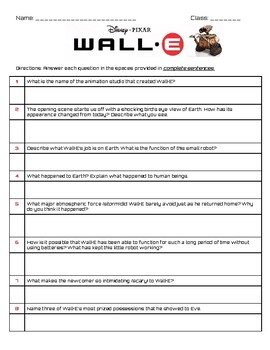Wall·E Movie Viewing Guide
Mrs Flynn Science
58 Followers
Grade Levels
4th - 11th, Higher Education, Homeschool
Subjects
Resource Type
Standards
NGSSMS-ESS3-2
NGSSMS-ESS1-3
NGSSMS-ESS3-5
NGSSMS-ESS3-4
NGSSMS-ESS3-3
Formats Included
- PDF
Pages
4 pages
Mrs Flynn Science
58 Followers
What educators are saying
Loved the types of questions. Really made students think about what was happening in the movie. I also added a few questions about non-verbal communication, wellness, and resolving conflict as a summary of everything discussed in our FACS class!
The questions asked challenged students’ thinking in developmentally appropriate ways. and allow students to demonstrate understanding. Learners needed additional support in academic vocabulary and this resource really helped
Description
I used this worksheet as an assignment while my middle school students watched Wall·E! I found this to be an excellent cautionary tale to add to any Environmental Science, Human Impact on the Environment, Ecology, or Climate Change unit.
Students will reason, write, draw conclusions, summarize and restate information and ideas presented from the movie.
Included is a link to my Wall·E Kahoot! activity that you can complete as a class as a review game! Detailed instructions are included in case you are new to Kahoot!
Please also find a link on the Teacher Page of the PDF that will allow you to make a copy of the original doc in your own Google Drive to edit as you see fit.
Answer Key now also included!!
Total Pages
4 pages
Answer Key
Included
Teaching Duration
2 hours
Report this resource to TPT
Reported resources will be reviewed by our team. Report this resource to let us know if this resource violates TPT’s content guidelines.
Standards
to see state-specific standards (only available in the US).
NGSSMS-ESS3-2
Analyze and interpret data on natural hazards to forecast future catastrophic events and inform the development of technologies to mitigate their effects. Emphasis is on how some natural hazards, such as volcanic eruptions and severe weather, are preceded by phenomena that allow for reliable predictions, but others, such as earthquakes, occur suddenly and with no notice, and thus are not yet predictable. Examples of natural hazards can be taken from interior processes (such as earthquakes and volcanic eruptions), surface processes (such as mass wasting and tsunamis), or severe weather events (such as hurricanes, tornadoes, and floods). Examples of data can include the locations, magnitudes, and frequencies of the natural hazards. Examples of technologies can be global (such as satellite systems to monitor hurricanes or forest fires) or local (such as building basements in tornado-prone regions or reservoirs to mitigate droughts).
NGSSMS-ESS1-3
Analyze and interpret data to determine scale properties of objects in the solar system. Emphasis is on the analysis of data from Earth-based instruments, space-based telescopes, and spacecraft to determine similarities and differences among solar system objects. Examples of scale properties include the sizes of an object’s layers (such as crust and atmosphere), surface features (such as volcanoes), and orbital radius. Examples of data include statistical information, drawings and photographs, and models. Assessment does not include recalling facts about properties of the planets and other solar system bodies.
NGSSMS-ESS3-5
Ask questions to clarify evidence of the factors that have caused the rise in global temperatures over the past century. Examples of factors include human activities (such as fossil fuel combustion, cement production, and agricultural activity) and natural processes (such as changes in incoming solar radiation or volcanic activity). Examples of evidence can include tables, graphs, and maps of global and regional temperatures, atmospheric levels of gases such as carbon dioxide and methane, and the rates of human activities. Emphasis is on the major role that human activities play in causing the rise in global temperatures.
NGSSMS-ESS3-4
Construct an argument supported by evidence for how increases in human population and per-capita consumption of natural resources impact Earth’s systems. Examples of evidence include grade-appropriate databases on human populations and the rates of consumption of food and natural resources (such as freshwater, mineral, and energy). Examples of impacts can include changes to the appearance, composition, and structure of Earth’s systems as well as the rates at which they change. The consequences of increases in human populations and consumption of natural resources are described by science, but science does not make the decisions for the actions society takes.
NGSSMS-ESS3-3
Apply scientific principles to design a method for monitoring and minimizing a human impact on the environment. Examples of the design process include examining human environmental impacts, assessing the kinds of solutions that are feasible, and designing and evaluating solutions that could reduce that impact. Examples of human impacts can include water usage (such as the withdrawal of water from streams and aquifers or the construction of dams and levees), land usage (such as urban development, agriculture, or the removal of wetlands), and pollution (such as of the air, water, or land).





